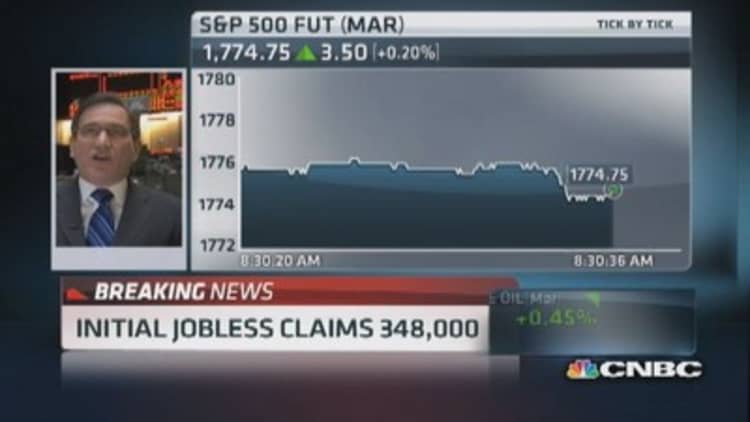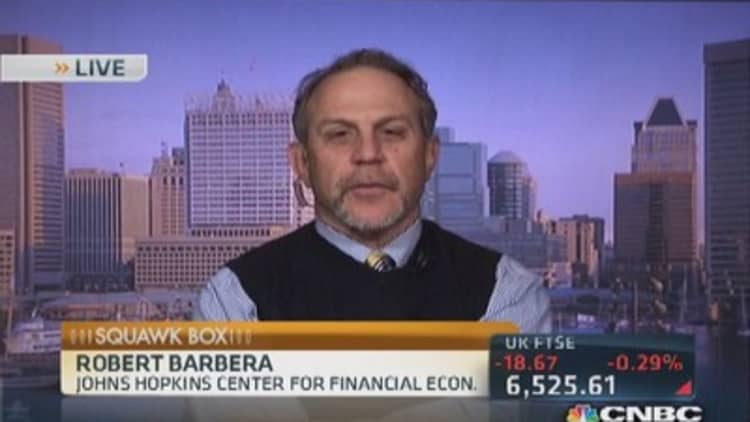
The number of Americans filing new claims for unemployment benefits rose more than expected last week, but the underlying trend suggested the labor market continued to heal.
Initial claims for state unemployment benefits increased 19,000 to a seasonally adjusted 348,000, the Labor Department said on Thursday. Claims for the prior week were revised to show 3,000 more applications received than previously reported.
Economists polled by Reuters had forecast first-time applications for jobless benefits rising to 330,000 in the week ended Jan. 25.
The four-week moving average for new claims, considered a better measure of underlying labor market conditions as it irons out week-to-week volatility, edged up 750 to 333,000.
A Labor Department analyst said claims for Louisiana were estimated because of inclement weather, adding there were no special factors affecting the state level data.
Last week's claims data include the Martin Luther King Jr Day and filings tend to be volatile around federal holidays.
Job growth slowed sharply in December, but economists shrugged off the surprise meager increase in payrolls, pointing to freezing temperatures that hit sectors such as construction and transportation.
Federal Reserve officials also appeared to dismiss the slowdown in payrolls, saying at the end of a two-day policy meeting on Wednesday that the labor market on balance showed further improvement.
The U.S. central bank announced another reduction to its monthly bond purchases on Wednesday.
The claims report showed the number of people still receiving benefits under regular state programs after an initial week of aid fell 16,000 to 2.99 million in the week ended Jan. 18.
The so-called continuing claims have been elevated in recent weeks and some economist say the cold weather could be preventing many recipients from going out to search for work and companies to delay hiring.

Robust household spending and rising exports kept the U.S. economy on solid ground in the fourth quarter, but stagnant wages could chip away some of the momentum in early 2014.
Gross domestic product grew at a 3.2 percent annual rate, the Commerce Department said, in line with expectations. While that was a slowdown from the third-quarter's brisk 4.1 percent pace, it was a far stronger performance than earlier anticipated and was welcome news in light of a 0.3 percentage point drag from October's partial government shutdown and a much smaller contribution to growth from a restocking by businesses.
Earlier in the quarter many economists were anticipating a growth pace below 2 percent given that an inventory surge accounted for much of the increase in the July-September period. Growth over the second half of the year come in at a 3.7 percent pace, up sharply from 1.8 percent in the first six months of the year. It was the biggest half-year increase since the second half of 2003.
Consumer spending was the main driver of fourth-quarter growth, but there was also help from other segments of the economy such as trade and business investment.
The advance fourth-quarter GDP was released a day after the Federal Reserve said "growth in economic activity picked up in recent quarters.''
The Fed on Wednesday announced another reduction to its monthly bond purchases and appeared to shrug off a surprise sharp slowdown in job growth in December. Consumer spending rose at a 3.3 percent rate, the strongest since the fourth quarter of 2010. Consumer spending, which accounts for more than two-thirds of U.S. economic activity, advanced at a 2 percent pace in the third quarter.
Businesses accumulated $127.2 billion worth of inventories, the most since the first quarter of 1998, adding 0.42 percentage point to GDP growth. Inventories had increased $115.7 billion in the third quarter, contributing 1.67 percentage points to output. Excluding inventories, the economy grew at a 2.8 percent rate, up from the third-quarter's 2.5 percent rate.
--By Reuters

